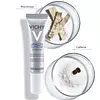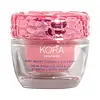What's inside
What's inside
 Key Ingredients
Key Ingredients

 Benefits
Benefits

 Concerns
Concerns

 Ingredients Side-by-side
Ingredients Side-by-side

Water
Skin ConditioningDimethicone
EmollientHydrogenated Polyisobutene
EmollientGlycerin
HumectantCetyl Alcohol
EmollientGlyceryl Stearate
EmollientPolymethyl Acrylate
Methyl Methacrylate
PEG-40 Stearate
EmulsifyingCera Alba
EmollientBeeswax
Emulsion StabilisingPotassium Cetyl Phosphate
EmulsifyingStearic Acid
CleansingStearyl Alcohol
EmollientSorbitan Tristearate
EmulsifyingTriethanolamine
BufferingCaffeine
Skin ConditioningMethylparaben
PreservativeSilica
AbrasiveSodium Benzoate
MaskingSodium Dextran Sulfate
Gel FormingMyristyl Alcohol
EmollientEscin
TonicPalmitic Acid
EmollientRhamnose
HumectantPhenoxyethanol
PreservativeAdenosine
Skin ConditioningMagnesium Ascorbyl Phosphate
AntioxidantTocopheryl Acetate
AntioxidantPoloxamer 338
EmulsifyingAscorbyl Glucoside
AntioxidantHydrolyzed Rice Protein
Skin ConditioningPentylene Glycol
Skin ConditioningWater, Dimethicone, Hydrogenated Polyisobutene, Glycerin, Cetyl Alcohol, Glyceryl Stearate, Polymethyl Acrylate, Methyl Methacrylate, PEG-40 Stearate, Cera Alba, Beeswax, Potassium Cetyl Phosphate, Stearic Acid, Stearyl Alcohol, Sorbitan Tristearate, Triethanolamine, Caffeine, Methylparaben, Silica, Sodium Benzoate, Sodium Dextran Sulfate, Myristyl Alcohol, Escin, Palmitic Acid, Rhamnose, Phenoxyethanol, Adenosine, Magnesium Ascorbyl Phosphate, Tocopheryl Acetate, Poloxamer 338, Ascorbyl Glucoside, Hydrolyzed Rice Protein, Pentylene Glycol
Aloe Barbadensis Leaf Juice
Skin ConditioningRosa Canina Seed Oil
EmollientGlycerin
HumectantBalanites Roxburghii Seed Oil
Skin ConditioningCetearyl Alcohol
EmollientWater
Skin ConditioningCoconut Alkanes
EmollientLactobacillus Ferment
Skin ConditioningOleic/Linoleic/Linolenic Polyglycerides
EmollientCetearyl Olivate
Sorbitan Olivate
EmulsifyingPropanediol
SolventAscorbyl Glucoside
AntioxidantPersea Gratissima Oil
Skin ConditioningHelianthus Annuus Seed Oil
EmollientLactobacillus
Skin ConditioningButyrospermum Parkii Butter
Skin ConditioningCoco-Caprylate/Caprate
EmollientPotassium Sorbate
PreservativeEclipta Prostrata Extract
Skin ConditioningCocos Nucifera Fruit Extract
EmollientChenopodium Quinoa Seed Extract
Skin ConditioningPanax Ginseng Root Extract
EmollientSclerotium Gum
Emulsion StabilisingRubus Chamaemorus Fruit Extract
AntioxidantMorinda Citrifolia Fruit Extract
Skin ConditioningSodium Phytate
Anigozanthos Flavidus Extract
Skin ConditioningMelia Azadirachta Leaf Extract
Skin ConditioningTerminalia Ferdinandiana Fruit Extract
AntioxidantSodium Benzoate
MaskingPotassium Hydroxide
BufferingHippophae Rhamnoides Fruit Oil
Skin ProtectingTocopherol
AntioxidantMoringa Oleifera Seed Oil
EmollientAlcohol
AntimicrobialAloe Barbadensis Leaf Juice, Rosa Canina Seed Oil, Glycerin, Balanites Roxburghii Seed Oil, Cetearyl Alcohol, Water, Coconut Alkanes, Lactobacillus Ferment, Oleic/Linoleic/Linolenic Polyglycerides, Cetearyl Olivate, Sorbitan Olivate, Propanediol, Ascorbyl Glucoside, Persea Gratissima Oil, Helianthus Annuus Seed Oil, Lactobacillus, Butyrospermum Parkii Butter, Coco-Caprylate/Caprate, Potassium Sorbate, Eclipta Prostrata Extract, Cocos Nucifera Fruit Extract, Chenopodium Quinoa Seed Extract, Panax Ginseng Root Extract, Sclerotium Gum, Rubus Chamaemorus Fruit Extract, Morinda Citrifolia Fruit Extract, Sodium Phytate, Anigozanthos Flavidus Extract, Melia Azadirachta Leaf Extract, Terminalia Ferdinandiana Fruit Extract, Sodium Benzoate, Potassium Hydroxide, Hippophae Rhamnoides Fruit Oil, Tocopherol, Moringa Oleifera Seed Oil, Alcohol
Ingredients Explained
These ingredients are found in both products.
Ingredients higher up in an ingredient list are typically present in a larger amount.
Ascorbyl Glucoside is a stable form of Vitamin C. It is created by combining glucose from starch.
When applied to skin, Ascorbyl Glucoside turns into Ascorbic Acid.
Ascorbyl Glucoside is an antioxidant. Antioxidants help fight free-radicals, or molecules that may damage skin cells.
It can help to reduce redness, improve skin texture, reduce the effects of aging, reduce the visibility of dark spots, and brighten skin.
Read more about other types of Vitamin C:
Learn more about Ascorbyl GlucosideGlycerin is already naturally found in your skin. It helps moisturize and protect your skin.
A study from 2016 found glycerin to be more effective as a humectant than AHAs and hyaluronic acid.
As a humectant, it helps the skin stay hydrated by pulling moisture to your skin. The low molecular weight of glycerin allows it to pull moisture into the deeper layers of your skin.
Hydrated skin improves your skin barrier; Your skin barrier helps protect against irritants and bacteria.
Glycerin has also been found to have antimicrobial and antiviral properties. Due to these properties, glycerin is often used in wound and burn treatments.
In cosmetics, glycerin is usually derived from plants such as soybean or palm. However, it can also be sourced from animals, such as tallow or animal fat.
This ingredient is organic, colorless, odorless, and non-toxic.
Glycerin is the name for this ingredient in American English. British English uses Glycerol/Glycerine.
Learn more about GlycerinSodium Benzoate is a preservative. It's used in both cosmetic and food products to inhibit the growth of mold and bacteria. It is typically produced synthetically.
Both the US FDA and EU Health Committee have approved the use of sodium benzoate. In the US, levels of 0.1% (of the total product) are allowed.
Sodium benzoate works as a preservative by inhibiting the growth of bacteria inside of cells. It prevents the cell from fermenting a type of sugar using an enzyme called phosphofructokinase.
It is the salt of benzoic acid. Foods containing sodium benzoate include soda, salad dressings, condiments, fruit juices, wines, and snack foods.
Studies for using ascorbic acid and sodium benzoate in cosmetics are lacking, especially in skincare routines with multiple steps.
We always recommend speaking with a professional, such as a dermatologist, if you have any concerns.
Learn more about Sodium BenzoateWater. It's the most common cosmetic ingredient of all. You'll usually see it at the top of ingredient lists, meaning that it makes up the largest part of the product.
So why is it so popular? Water most often acts as a solvent - this means that it helps dissolve other ingredients into the formulation.
You'll also recognize water as that liquid we all need to stay alive. If you see this, drink a glass of water. Stay hydrated!
Learn more about Water